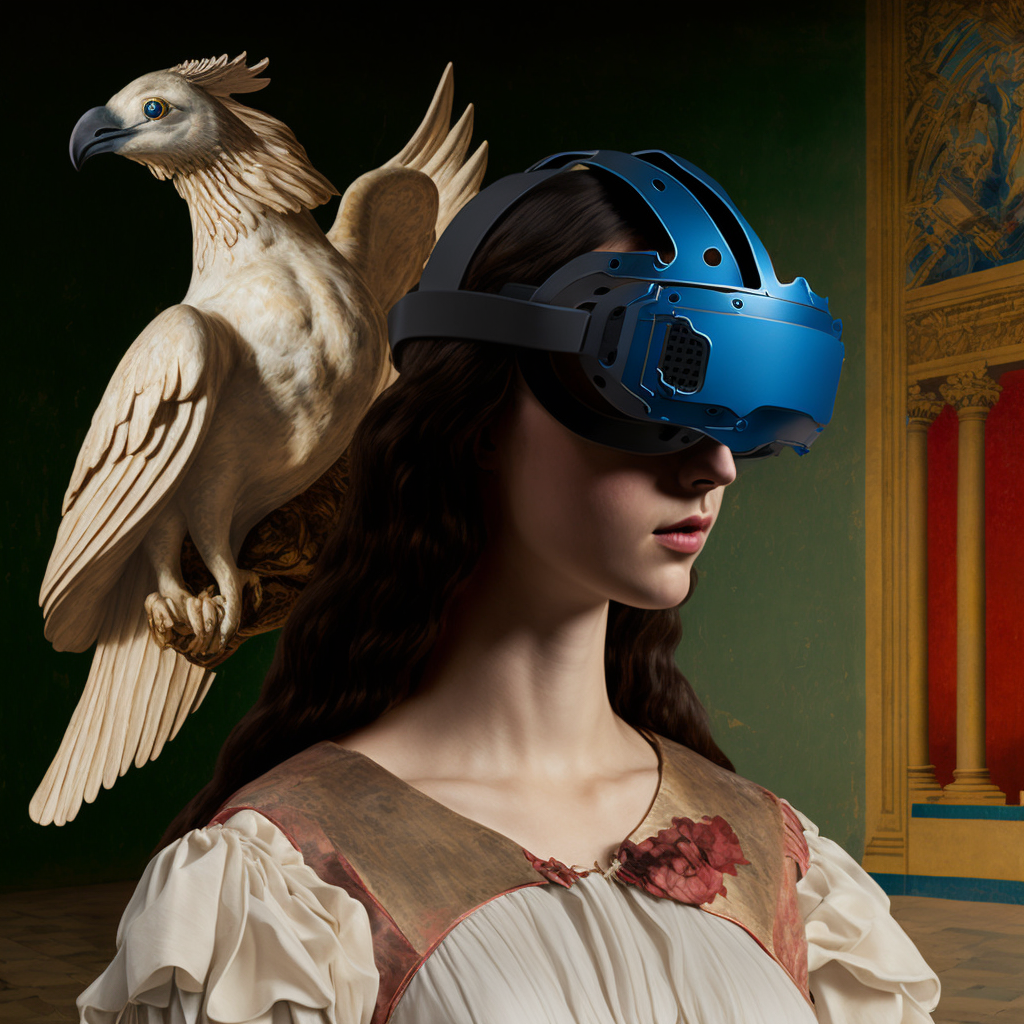On Media Genealogy and Forecasting

Last year, I wrote reviews of Reality Media: Augmented and Virtual Reality by Jay David Bolter, Maria Engberg, and Blair MacIntyre (2021), and The Aesthetics of Virtual Reality by Grant Tavinor (2021). While the books aim to do different things, a shared feature is that they each dedicate a chapter to media genealogy. Both delve into immersive technologies’ developmental lineages. It’s noted how XR headsets are preceded by general-purpose computers, 3D computer-generated imagery, and cinema. Cinema is preceded by photography. Photography follows from developments in linear perspective, and so on. A reasonable assumption made by the books’ respective authors is that we can gain insights from retrojecting a medium’s family tree. Let’s elaborate this idea before playfully underscoring its limitations as a forecasting tool.
Occasionally throughout history, a kind of cross-generational cross-pollination seems to occur among image production and display technologies. Significant leaps forward can happen with little apparent foreshadowing. An example is holographic mixed reality (MR) headsets like the HoloLens or Magic Leap. If we desire, we can frame such present-day innovations as derived from experiments of the distant past, perhaps in an attempt to explain their origins and aetiology. By this I mean, MR may appear to the consumer public as sui generis. To non-experts, it can seem as if MR holography defies the kind of slow, incremental evolutionary improvements seen in biology and technology alike. Where did this extraordinary technology come from? It’s commercially unprecedented.
Academics, meanwhile, may readily link MR to an historic imaging experiment. We might note that the very idea of projecting a kind of “spectral” image onto or into a piece of glass positioned in front of the eye is first seen in the work of Filippo Brunelleschi. The Early Renaissance-era architect used a mirror and a painting of one of his buildings (both with peep-holes drilled in them) to superimpose a cathedral over the top of its physical double. And if that ain’t augmenting reality, then I don’t know what is! Hence given their similitude, it can be tempting to argue, for example, that modern-day AR or MR headsets “remediate” Brunelleschi’s mirror, combining his crude but revolutionary imaging device with digital computation, bridging centuries of technological inactivity in terms of projecting things onto or into glass. It’s romantic and seductive to unite past and present by suggesting that when we don XR headsets, we’re staring into Brunelleschi’s mirror, or that when we gawp at screens, we’re gazing through Alberti’s window (Friedberg 2006; Grau 2003).
Respectfully, though, I suggest that there’s limited mileage in such a media-genealogical method—particularly if the goal is to scaffold predictions about the future. This isn’t to be contrarian or to dismiss the productive insights of the above-cited books. I just want to problematise the implicit idea that we can paint a well-rounded picture of a thing by privileging its materiality, form factor, or perceptual–cognitive M.O. over its sociocultural and -political affordances, which I think are scarcely graspable if we spotlight a medium’s formal ontogenic emergence.
I’ll first sketch what Bolter et al. and Tavinor mean by “remediate” or “remediation”. I’ll then suggest that framing XR technologies as fundamentally illusionistic tells us more about how they act upon individuals’ sensoria than how they stand to impact the world. I’ll end by asserting that if we want to predict what’s at stake in the widespread consumer adoption of XR headsets (soon, spectacles; later, contact lenses; ultimately, BCIs or drugs), we might consider downplaying or moving beyond the fact that such media function at the individual level by way of optical, auditory, and kinaesthetic trickery. Rather than comparing XR to trompe-l’œil paintings or focusing on how they remediate optics, we might instead emphasise underlying architectures and affordances, comparing the fledgling family of media nodes that is XR most closely to the Internet itself.
So—what is “remediation”? Lead author of Reality Media, Jay David Bolter, seems to have coined the term in Remediation: Understanding New Media (Bolter & Grusin 1999). Simply put, remediation is when we see traces of older media in newer or nascent media. Bolter and Grusin note how empirically, “at this extended historical moment, all current media function as remediators [of their forebears,] and that remediation offers us a means of interpreting the work of earlier media as well” (p. 55). This isn’t an a priori truth, they add, but a function of cultural practices and analytic perspectives in tandem. In the West, early cinema re-mediated theatre insofar as cameras were initially static, editing was non-existent, scenes and shots were blocked or staged as if under proscenia, and actors gave wooden yet hammy performances to best address what they felt to be a far-off audience. Directors didn’t know how else to do movies: A bespoke aesthetics of film hadn’t yet coalesced. Cinema, a broadly mimetic artform, thus initially remediated the visual perspective of historic theatregoers (Bordwell 1985). And continuing this trend, for Bolter and Grusin, VR “is as a remediation of the subjective style of film” (p. 165). “When we participate in virtual reality, our digital point of view is understood as a remediation of the point of view that we have occupied for decades in film … and for centuries in photography and paintings” (p. 232). “Virtual reality [therefore] offers a remediated definition of the self as a new kind of camera” (p. 248).
Bolter et al.’s Reality Media (2021) sets out with a slightly different conception of remediation. The term is introduced as “the process of the mutual competition and cooperation among all media at any current cultural moment” (p. xxi), and examples include how VR “easily” remediates the flat-screen genre of first-person shooter games (p. 2). An inevitable observation, maybe. It seems as if for Bolter and co-authors, everything comes back to the eye—and moreover photorealism. Emphasising sensory perception above all else, Bolter, Engberg, and MacIntyre write that “[t]his is how remediation works: a newer medium depends on an older, familiar medium for its definition of reality” (p. 51).
Tavinor’s version of remediation in The Aesthetics of Virtual Reality (2021) is at once more nuanced and grounded in explicit, stepwise philosophical enquiry. He doesn’t cite Bolter and colleagues, instead employing bottom-up conceptual analysis to robustly characterise medium and virtuality—first separately, then jointly—arriving at a unified definition of virtual media, or a virtual medium. Part of what allows him to mount a convincing case is that his understanding of media—and what can be achieved thereby—is broader than that of most media scholars, not limited to communication media per se. Take his example of online shopping. A brick-and-mortar shop is like an oil painting: They’re both made possible in the first instance by physical media. Their respective functions—purveying commodities and depicting a subject or object—are not, however, determined by their materiality. An online shop comprised of and enabled by HTML, JavaScript, and PHP “remediates” its Highstreet counterpart in much the same way a JPG encodes bits and bytes to re-present and remediate, say, The Garden of Earthly Delights. (This is not to suggest, of course, that computational processes aren’t rooted in physical ones.) For Tavinor, VR remediates not photorealism, as Bolter et al. hold, but visuospatial experience. That is, the way we inhabit and perceive physical reality and the agents it contains. (See also Qvortrup 2002.)
“How will bad-faith actors leverage XR once we’re all sharing the same “consensual hallucination”… Or, more worryingly—and perhaps, if we can extrapolate current trends, more probably—when each one of us is living in our own XR private echo-chamber-cum-filter-bubble? Our own private spatial feed?”
Tavinor’s remediation can be seen to focus us not so much on media’s material or phenomenal correspondences as advancements in their affordances. His media genealogy does not so much lead us to think ancestor and descendent need be functionally similar, or engaged in a kind of competition. If we expand this approach beyond subjective experiential affordances to additionally encompass interpersonal, communicative, discursive, and rhetorical affordances, we’ll get better purchase on what’s at stake in XR’s eventual mainstream adoption. Indeed, this is what Bolter is hinting at when he and Richard Grusin note in passing that “virtual reality is not only a head-mounted display and computer hardware and software; it is also the sum of the entertainment and training uses to which this hardware and software is put” (Bolter & Grusin 1999, p. 77 – my italics). The question is, what will those uses transpire to be? How will bad-faith actors leverage XR once we’re all sharing the same “consensual hallucination” (Gibson 1984, p. 5)? Or, more worryingly—and perhaps, if we can extrapolate current trends, more probably—when each one of us is living in our own XR private echo-chamber-cum-filter-bubble? Our own private spatial feed? I’m doubtful that media genealogy alone can shed much light on these questions, as the method generally obscures that XR is taking shape as a (family of) network technology/ies, concentrating instead on illusions of presence.
To be clear, XR is undeniably illusionistic. It can be compared to, and seen as descended from, stereoscopes, stereograms, and so on. Backfilling XR’s family tree—that is, comparing it to representational media from Pompeiani mosaics, through panorama paintings (Grau 2003), to the Lumières’ Train Pulling into a Station (Bolter et al. 2021)—is an endlessly fascinating exercise, and I’m guilty of focusing on VR’s perceptual and experiential idiosyncrasies in my own work (Murphy 2021). But if we want to predict how XR might affect culture and society; if we want to see the bigger picture, we’ll do well to prepare for a worst-case scenario by looking at the Internet: Specifically, sites and services like 4chan, Facebook, and Twitter, and the tectonic trouble they’ve slowly and sometimes subtly but undeniably caused.
Misinformation is rife, exacerbating what can aptly if performatively be called a culture war. Scholars ought therefore to concentrate on how XR may serve as an extension or offshoot of social media and online communication platforms. If you’ve ever attended a family gathering and been surprised to learn that grandma is now an antivaxxer, convinced that Bill Gates invented COVID-19 because a Twitter user called FreedomEagle88 shared a heavily redacted CIA document “proving” as much, then imagine how intractable the situation will be when agents of chaos can beam a volumetric XR deepfake of George Soros admitting his conspiratorial crimes directly into your media-illiterate relatives’ living rooms. I am, of course, being facetious. But this is because the future is hard if not impossible to predict. The point is that if text and 2D images can distort people’s perception of reality, XR will compound societies’ tendency to be drawn in and swayed by pseudo-news that’s deliberately designed to exploit cognitive biases and unconscious prejudices. If the future is smoke and mirrors, then endless reflections on Brunelleschi’s experiment won’t even get us half way there.
References
Bolter, J. D., Engberg, M., & MacIntyre, B. (2021). Reality Media: Augmented and Virtual Reality. MIT Press.
Bolter, J. D., & Grusin, R. (1999). Remediation: Understanding New Media. The MIT Press.
Bordwell, D. (1985). Narration in the Fiction Film. The University of Wisconsin Press.
Friedberg, A. (2006). The Virtual Window: From Alberti to Microsoft. The MIT Press.
Gibson, W. (1984). Neuromancer. Ace.
Grau, O. (2003). Virtual Art: From Illusion to Immersion. The MIT Press.
Murphy, D. (2021). Through the Screen Door: Virtual Reality Experiences. University of Copenhagen.
Qvortrup, L. (2002). Cyberspace as Representation of Space Experience: In Defence of a Phenomenological Approach. In L. Qvortrup, J. F. Jensen, E. Kjems, N. Lehmann, & K. Madsen (Eds.), Virtual Space: Spatiality in Virtual Inhabited 3D Worlds (pp. 5–24). Springer-Verlag. https://doi.org/10.1007/978-1-4471-0225-0
Tavinor, G. (2021). The Aesthetics of Virtual Reality. Routledge. https://doi.org/10.4324/9781003107644
Recommended citation
Murphy, D. (March, 2023) On Media Genea. Critical Augmented and Virtual Reality Researchers Network (CAVRN). link
This work is licensed under a Creative Commons Attribution-NonCommercial-NoDerivatives 4.0 International License.
